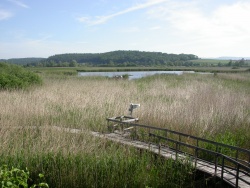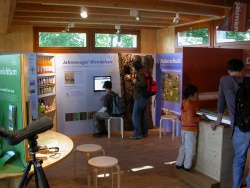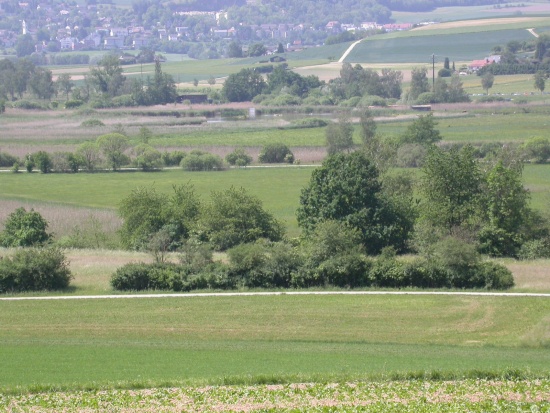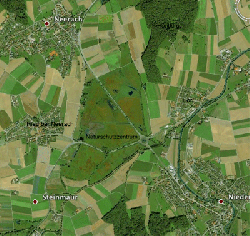Overview
The Neeracherried is with one sqkm the biggest swamp in the lowlands of Switzerland. It lies in the Kanton of Zürich, near the airport between the villages of Ried, Neerach and Höri. It's divided by two large roads but the big sedge and reed areas are still important for plants, birds and other animals.
The area is totally protected and carefully managed. In parts of the area Highland cattle are doing fine work for conservation. Since 1999 Birdlife Switzerland has a visitor centre and two hides in one corner of the area.
Birds
Notable Species
In winter hundreds of Red Kite are wintering in the Neeracherried and the surrounding area. They also breed here in good numbers and are easy to see. Several species of duck stay in winter and some Great Egret too. If the lagoon freezes, the reserve gets quite birdless.
In spring a lot of migrants can be seen, specially waders and herons and egrets. Black-headed Gull (and usually one pair of Yellow-legged Gull) are breeding and some pairs of Northern Lapwing.
Beside the Common Reed Warbler some Great Reed Warbler and notably Savi's Warbler are singing in the reed. Common Grasshopper Warbler occurs as well. In bushes Common Nightingale is singing all night in late April and Little Bittern are callling at night as well. Common Kingfisher has breed, but has disappeard now.
Common Cuckoo is often heard and sometimes seen and Eurasian Hobby are hunting for dragonflies.
The Neeracherried is famous for its rails. In some years all four species, Water Rail, Spotted Crake, Little Crake and Baillon's Crake are recorded. They are very hard to see and are best heard in the middle of the night from the roadside. White Stork can be seen in spring and summer.
Rarities
Most rarities turn up in May or in September. Among them are Great Snipe, Pectoral Sandpiper, Squacco Heron, Black-winged Stilt, Black-winged Kite and many more.
Check-list

Birds you can see here include:
Little Grebe, Great Crested Grebe, Black-necked Grebe, Great Cormorant, Great Bittern, Little Bittern,Great Egret, Grey Heron, Purple Heron, White Stork, Black Stork,Common Shelduck, Eurasian Wigeon, Gadwall, Common Teal, Mallard, Northern Pintail, Garganey, Northern Shoveler, Red-crested Pochard, Common Pochard, Ferruginous Pochard, Tufted Duck, European Honey Buzzard, Black Kite, Red Kite Western Marsh Harrier, Eurasian Goshawk, Eurasian Sparrowhawk, Common Buzzard, Osprey, Common Kestrel, Eurasian Hobby, Water Rail, Spotted Crake, Little Crake, Baillon's Crake, Common Moorhen, Common Coot, Little Ringed Plover, Ringed Plover, Northern Lapwing, Little Stint, Temminck's Stint, Dunlin, Ruff, Common Snipe, Black-tailed Godwit, Eurasian Curlew, Common Redshank, Common Greenshank, Green Sandpiper, Wood Sandpiper, Common Sandpiper, Ruddy Turnstone, Mediterranean Gull, Black-headed Gull, Common Gull, Lesser Black-backed Gull, Yellow-legged Gull, Common Tern, Whiskered Tern, Black Tern, Common Cuckoo, Common Kingfisher, Sand Martin, Barn Swallow, Western House Martin, Meadow Pipit, Water Pipit, Yellow Wagtail, Grey Wagtail, Common Nightingale, Bluethroat, European Stonechat, Savi's Warbler, Common Grasshopper Warbler, Common Reed Warbler, Great Reed Warbler, Common Chiffchaff, Willow Warbler, Spotted Flycatcher, Eurasian Penduline Tit, Great Grey Shrike, Chaffinch, European Greenfinch, European Goldfinch, Reed Bunting
Other Wildlife

Roe Deer can be seen regulary, Red Fox sometimes. If you're out at night (searching for calling crakes maybe) it's worth to look out for fireflies. The females are glowiing in May and June to attract the males and are easily found along the roadside.
Site Information
History and Use
The Neeracherried is just the rest of a once huge swamp area, including todays Zurich Airport. Most parts were cultivated in the last hundred years. The Neeracherried was also used by farmers.
Since 1927 the Swiss Ala manages and protects the area. Nowadays a nature centre allows access without disturbance. The area is totally protected. There are also plans to remove and rebuilt the roads outside of the protected areas.
Areas of Interest
The main attraction is the centre itself and the view from the hides. But it is also worthwile to walk around the area, especially in spring. You could visit the centre in early morning and then walk around clockwise in order to find some more raptors or other species like Red-backed Shrike. The Höriberg east of the Neeracherried holds all lowland wood species, including Black Woodpecker and Green Woodpecker.
Access and Facilities

Riedt bei Neerach is the nearest busstop and can be reached in 29 minutes from Zürich by train and bus or in 35 minutes from the airport (direct bus nr 510). From the bus stop it's a 5 minutes walk to the centre.
It is also very worthwile to explore the area by bike. There is a carpark at the visitor centre on the road from Dielsdorf to Bülach and another one near the roundabout at Oberhöri. The visitor centre has an exhibition and is the only way to access the two hides. The first one to the right is very nice in late summer and autumn, when the water level is down.
In spring the waders are found from the second hide. At the centre is also a platform which is always open and gives you a good overview.
The centre is open from April to October on Wednesday, 2pm to 8pm, Saturday, 10am to 6pm and Sunday 8am to 6pm. The entry fee is 7 Swiss Francs for an adult. Outside this time the platform is accessible and the best way to see waders (but from far away) is from the road just north of the centre. If you're only birding from the hides, binoculars may be good enough, however I always prefer to have the scope with me. If the centre is closed you will need a scope to see some birds.
It is possible to have guided tours (except on Mondays) for groups. Contact the centre for that well in advance!
Contact Details
SVS-Naturschutzzentrum Neeracherried
Postfach
8173 Neerach
phone (in Switzerland) 044 858 13 00
mail: neeracherried@birdlife.ch





